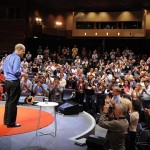 Public speaking is something that most of us have to do something of in our professional lives, and so learning how to be better at it is highly important. New research from the University of Zurich explores what lessons we might learn from the TED conferences in terms of what makes a good speaker.
Public speaking is something that most of us have to do something of in our professional lives, and so learning how to be better at it is highly important. New research from the University of Zurich explores what lessons we might learn from the TED conferences in terms of what makes a good speaker.
The researchers wanted to test whether social evaluations function in the same way online as they do offline. They chose the TED conferences as the Petri dish for their experiment. The talks have been uploaded onto the hugely popular TEDTalks website, with each video gaining around two million views on average.
Transcripts of each TED video were collected along with both the ratings each video received and the number of views. The researchers attempted to analyze the language used in each video, and especially the perceived gender of the language.
Gendered language
They suggest that when men speak, we often use more abstract and analytical language, but women are more likely to use social, emotional, and narrative-driven language.
The analysis reveals that 70% of the speakers used a language style that matched their own gender. Was either style more likely to deliver a successful talk, however?
“Due to the well documented male advantage in social influence, we expected a general advantage of male-typical language style in terms of talk impact,” the researchers say. “We assumed that this might be the case for women in particular, namely that a male language style might help them overcome the ascribed lower status typically associated with their gender.”
What actually unfolded was the opposite, with female-typical language appearing to have the biggest impact on both the ratings and views received by a talk.
Impactful talks
“Most importantly, female-typical language was associated with more talk views irrespective of the speaker’s gender,” the researchers explain. “Female-typical language thus conferred an advantage for male and female speakers alike in our sample. In other words, behavior typically shown by women was associated with higher talk impact.”
Indeed, the use of female language style was associated with a boost in views of over 700,000. There was also a boost received to the ratings of the talks, with more common use of adjectives such as “funny” and “beautiful”, whereas those talks using male-typical language receiving adjectives such as “informative” and “fascinating”.
The researchers suggest that these differences are in line with gender stereotypes that associate women with warmth and emotional expression, and men with facts and figures. They do say, however, that this didn’t appear to interfere with the popularity online, as more female-typical language also resulted in fewer “unconvincing” ratings.
“Female-typical language may thus be a powerful tool to promote impact and visibility particularly for speakers whose competence or status is out of the question—independent of whether they are male or female,” the researchers conclude.